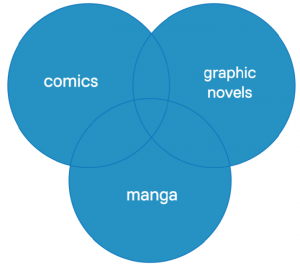Chapter 8: Gathering Research and Establishing Evidence
OR Operator
The operator OR is used to broaden a search by combining two or more variables into one set. The operator OR is used to combine synonyms and variant spellings (e.g. theatre OR theater) of a word into one search. Any one of the search terms must be present. More than one can be present.
A Venn diagram (also known as a set diagram) can visually display how a database’s search engine handles search terms and the Boolean operators. Each term is searched separately and all of the relevant hits (articles, books etcetera identified in the database as containing that term) are grouped into separate sets, one set per term as represented by each circle. In the diagram that follows, three different related terms are being searched: comics shown by the circle in the upper left, graphic novels shown by the circle in the upper right, with manga shown by the circle at the bottom of the diagram. Some of the hits also contain one or both of the other search terms and this is represented by the overlapping of the circles. In the example, since the OR operator is being used, the search finds all of the hits containing any of terms and combines them all into one large pool of results. Because all of the results in all three sets are included, they are all represented using the same blue colour.
To reiterate, by broadening a search using the OR operator, the results of a search can be much larger and more comprehensive than a set of results from a search that does not make use of related terms, synonyms, and, variant spellings joined with the OR operator.
Example Venn diagram using the OR operator: comics OR graphic novels OR manga


